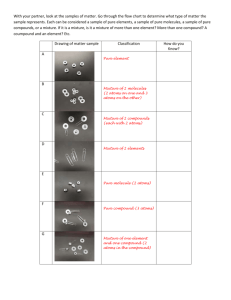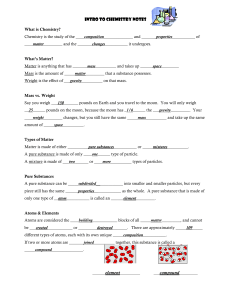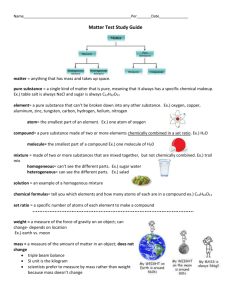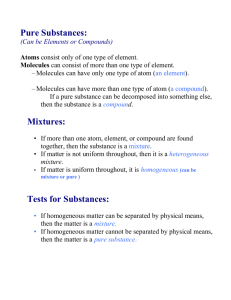Grade 9 Science EXAM REVIEW – CHEMISTRY
advertisement
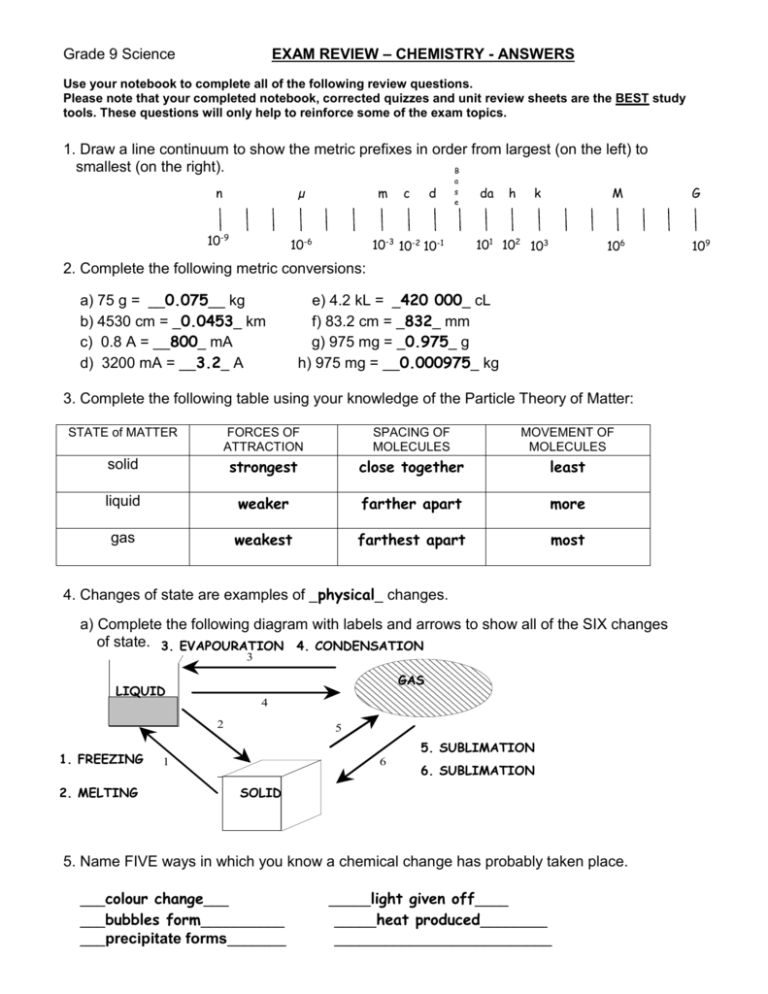
EXAM REVIEW – CHEMISTRY - ANSWERS Grade 9 Science Use your notebook to complete all of the following review questions. Please note that your completed notebook, corrected quizzes and unit review sheets are the BEST study tools. These questions will only help to reinforce some of the exam topics. 1. Draw a line continuum to show the metric prefixes in order from largest (on the left) to smallest (on the right). B n µ 10-9 10-6 m c d a s e 10-3 10-2 10-1 da h k M 101 102 103 106 2. Complete the following metric conversions: a) 75 g = __0.075__ kg b) 4530 cm = _0.0453_ km c) 0.8 A = __800_ mA d) 3200 mA = __3.2_ A e) 4.2 kL = _420 000_ cL f) 83.2 cm = _832_ mm g) 975 mg = _0.975_ g h) 975 mg = __0.000975_ kg 3. Complete the following table using your knowledge of the Particle Theory of Matter: STATE of MATTER FORCES OF ATTRACTION SPACING OF MOLECULES MOVEMENT OF MOLECULES solid strongest close together least liquid weaker farther apart more gas weakest farthest apart most 4. Changes of state are examples of _physical_ changes. a) Complete the following diagram with labels and arrows to show all of the SIX changes of state. 3. EVAPOURATION 4. CONDENSATION 3 GAS LIQUID 4 2 1. FREEZING 2. MELTING 5 5. SUBLIMATION 1 6 6. SUBLIMATION SOLID 5. Name FIVE ways in which you know a chemical change has probably taken place. ___colour change___ ___bubbles form__________ ___precipitate forms_______ _____light given off____ _____heat produced________ __________________________ G 109 6. Identify each of the following examples as either physical or chemical changes: a) clothes dried in an electric dryer __physical____ b) clothes dried while hanging outdoors __physical____ c) hamburger is cooked __chemical___ d) wood burning __chemical__ e) frost forming on a car windshield __physical___ f) a penny tarnishes __chemical__ 7. Complete the missing values in the following table: MASS 25.0 g 3.0 g 400 g 9400 g 414.63 g 250 g 80.5 g VOLUME 40 mL 2.0 mL 15 cm3 200 L 40.65 cm3 DENSITY 0.625 g/mL 1.5 g/mL 26.7 g/cm3 47 g/L 10.2 g/cm3 16 g/mL 25 g/L 15.625 mL 3.22 L 8. Graph the data from the table of values below (include a proper title, label the axes, and point protectors). Use as much of the axis as possible when choosing your scale for the graph. a) Draw a line of best fit for the data. b) Find the slope of the line of best fit. 30 10 y y D = 2 1 D = D = 1.33 g/mL 25 10 x2 x1 Mass vs. Volume c) What physical property of matter does Θ the slope represent? 60 Density Volume (mL) Mass (g) M 10 10 a 20 15 s 30 25 s 40 30 Θ (g) 60 45 Θ Θ Θ 0 Θ Volume (mL) 80 9. A 40 g jewel has a density of 2.5 g/mL. It is submerged in a graduated cylinder that has 15 mL of water already in it. When the jewel is placed inside the graduated cylinder, what will the new reading be? (HINT: Calculate the volume of the jewel first and use GRASP). G: R: A: S: m = 40 g, D = 2.5 g/mL, Vi = 15 mL Vf = ?, Vobject = ? Vobject = m/D Vf = Vobject + Vinitial Vobject = (40)/(2.5) = 16 + 15 = 16 mL = 31 mL P: Therefore the final reading of the graduated cylinder will be 31 mL. 10. For each of the properties listed below: give an explanation and identify if it is a physical or chemical property. a) lustre: Physical: how well an object reflects like b) malleability: Physical: how easily an object can be re-shaped c) ductility: Physical: the ability of an object to be stretched into a wire d) combustability: Chemical: the ability to burn in oxygen e) reacts with acid: Chemcial: how an object reacts with acid f) conductivity: Physical: how well an object can conduct electricity g) solubility: Physical: how well a chemical can dissolve in water h) hardness: Physical: how well an object can resist pressure i) reacts with water: Chemical: how an object interacts with water j) state: Physical: solid, liquid, or gas k) brittleness: Physical: how easily the object breaks 11. a) Identify the following substances as pure substances or mixtures. b) Once you have completed a), identify the type of mixture or pure substance each substance is. i) raisin bran cereal __mixture___ __mechanical mixture___ ii) shaving cream __mixture_________ __solution_____ iii) pure water __pure substance__ __compound___________ iv) nail polish remover _pure substance_____ __compound_________ v) salt __pure substance_____ __compound_________ vi) oxygen __pure substance__ ___element_________________ vii) muddy water __mixture___________ __mechanical mixture______ 12. Complete the following chart on the Classification of Matter. Matter Pure Substances Mixtures Mechanical Mixture Solution Compounds 13. For each chemical formula: a) state the number of atoms of each element that make up the formula b) state the total number of atoms in the formula Number of atoms of each Number of atoms in element the molecule H2O 2-Hydrogen 3 atoms NaCl MgCO3 K2CO3 CH4 1-Oxygen 1-Sodium 1-Chlorine 1-Magnesium 1-Carbon 3-Oxygen 2-Potassium 1-Carbon 3-Oxygen 1-Carbon 4-Hydrogen 2 atoms 5 atoms 6 atoms 5 atoms Elements 14. Complete the following paragraphs on the atom. Matter is made up of small particles called _atoms_. There are smaller pieces that make up atoms called _subatomic_ _particles_, of which there are three types; _protons__, __neutrons___ and __electrons___. Most of the mass of the atom is located in its core called the _nucleus_ which contains __neutrons__ which are neutral (no charge) and _protons_ which are positively charged. __electrons_, which are negatively charged, are thought to move around the core in orbits. 15. Using the Periodic Table of Elements in your notebook, complete the following table: Element Name Symbol of Atom Scientific Notation oxygen O 16 sulphur S 32 calcium Ca Atomic Number # of electrons # of protons # of neutrons 8O 16 8 8 8 8 16S 32 16 16 16 16 40 20 20 20 20 9 4 4 4 5 65 30 30 30 35 80 35 35 35 45 40 Ca 20 9 beryllium Mass Number 4Be Be zinc Zn 65 bromine Br 80 30Zn 35Br 16. Compare the following terms: homogeneous (solution) and heterogeneous (mechanical mixture) Homogeneous: solution where one phase is visible Heterogeneous: mixture where two or more phases are visible physical property and chemical property element and compound Physical property: any property used to characterize matter and energy and their interactions Chemical property: describes how a substance reacts with other substances Metal: lustrous, malleable, solid (Hg is a liquid) conductor of heat and electricity. It is found left of the staircase on the PT Non-Metal: dull, brittle, solid, liquid, or gas, poor conductor, found on the right side of the PT Element: made of only one type of atom. pure substance and mixture Compound: made of two or more types of atoms. Pure substance: made of an element or compound metal and non-metal Mixture: contains two or more elements or compounds 17. Give the location and reactivity of: alkali metals, halogens, alkaline earth metals, noble gases Alkali metals – Group I (most reactive metals, Fr) Alkaline earth metals – Group II (less reactive than group 1) Halogens – Group VII (most reactive non-metals, F) Noble gases – Group VIII (unreactive due to a full outer shell) 18. Draw Bohr- Rutherford diagrams for: a) Sulfur b) Sodium c) Phosphorous d) Argon
